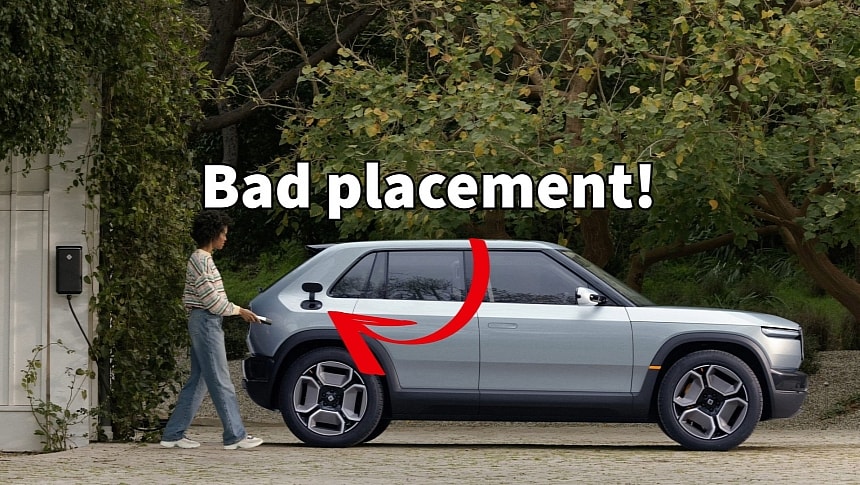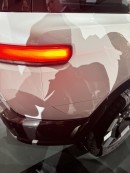Under the NACS deal, carmakers promised to adopt the NACS port in their vehicles starting from 2025. Rivian was the first to showcase NACS-enabled EVs. However, simply because the R2, R3, and R3X crossovers come with the NACS port doesn't mean they follow Tesla's recommendations.
Ever since Tesla opened the Supercharger stations in the US to non-Tesla EVs, it became obvious that this would not happen peacefully. People bickered about Supercharger etiquette, clogged stations, and, soon, charge port placement. Although Tesla owners were pleased to share the mission with other owners, they were not happy to share the actual chargers.
At first, the problem was generated by slow-charging EVs, like the Chevy Bolt, which only supports 50 kW charging. This means they need to spend more time charging and blocking the stalls for Tesla owners. The discussion later moved to "what's in it for me." Soon, people discovered that other EVs were different. More specifically, the charge port was placed in awkward locations.
All Tesla EVs have the charge port in the rear on the driver's side. However, most non-Tesla EVs have it in the front on the driver's side. Since the Supercharger stations were designed with Tesla EVs in mind, the charge cord is too short to reach other positions. This raised new questions because parking close enough to reach the charge port would often result in blocking the adjacent spots.
The discussion has intensified now that Tesla has signed deals with almost all carmakers to adopt the NACS standard. All participating EVs can use the Supercharger network as part of the deal. Ford was the first carmaker to gain access to the Supercharger network, so we've already seen what this meant for the "Supercharger etiquette."
In many cases, the Ford F-150 Lightning and Mustang Mach-E owners had to block two spots to get to the charger. Some Ford owners were disappointed to see Teslas occupying every other place, thus making it impossible to charge a non-Tesla EV. This may sound outrageous, but it has a benign cause. In the past era, when two Supercharger stalls shared the same power source, Tesla owners were conditioned to leave one spot between their cars. This way, they wouldn't have to share power with the guy beside them.
Many thought that the first non-Tesla electric vehicles would respect Tesla's recommendations to place the charge port either on the rear left or front right. This way, EV owners can charge like any Tesla EV by parking front-first or rear-first as required. However, Rivian disappointed everyone when it unveiled the R2, R3, and R3X. They all have the charge port in the worst possible place: the rear right.
This means not only that they will block two spots at the Supercharger but also that the driver will have to walk around the car every time they need to charge. Some argued that placing it on the passenger's side is better for curb charging. However, curb charging is non-existent in the US, and some argue that the Brits, Aussies, and others in left-hand traffic countries might feel disadvantaged.
Of course, the Rivian compact EVs will only start deliveries in 2026 at the earliest, so there's plenty of time for Tesla to upgrade its network to V4 Superchargers, which have longer cables. By then, this bickering should also subside. After all, EVs of all sorts have shared Supercharger stations in Europe since 2021, and all coexisted peacefully.
At first, the problem was generated by slow-charging EVs, like the Chevy Bolt, which only supports 50 kW charging. This means they need to spend more time charging and blocking the stalls for Tesla owners. The discussion later moved to "what's in it for me." Soon, people discovered that other EVs were different. More specifically, the charge port was placed in awkward locations.
All Tesla EVs have the charge port in the rear on the driver's side. However, most non-Tesla EVs have it in the front on the driver's side. Since the Supercharger stations were designed with Tesla EVs in mind, the charge cord is too short to reach other positions. This raised new questions because parking close enough to reach the charge port would often result in blocking the adjacent spots.
The discussion has intensified now that Tesla has signed deals with almost all carmakers to adopt the NACS standard. All participating EVs can use the Supercharger network as part of the deal. Ford was the first carmaker to gain access to the Supercharger network, so we've already seen what this meant for the "Supercharger etiquette."
In many cases, the Ford F-150 Lightning and Mustang Mach-E owners had to block two spots to get to the charger. Some Ford owners were disappointed to see Teslas occupying every other place, thus making it impossible to charge a non-Tesla EV. This may sound outrageous, but it has a benign cause. In the past era, when two Supercharger stalls shared the same power source, Tesla owners were conditioned to leave one spot between their cars. This way, they wouldn't have to share power with the guy beside them.
Many thought that the first non-Tesla electric vehicles would respect Tesla's recommendations to place the charge port either on the rear left or front right. This way, EV owners can charge like any Tesla EV by parking front-first or rear-first as required. However, Rivian disappointed everyone when it unveiled the R2, R3, and R3X. They all have the charge port in the worst possible place: the rear right.
This means not only that they will block two spots at the Supercharger but also that the driver will have to walk around the car every time they need to charge. Some argued that placing it on the passenger's side is better for curb charging. However, curb charging is non-existent in the US, and some argue that the Brits, Aussies, and others in left-hand traffic countries might feel disadvantaged.
Of course, the Rivian compact EVs will only start deliveries in 2026 at the earliest, so there's plenty of time for Tesla to upgrade its network to V4 Superchargers, which have longer cables. By then, this bickering should also subside. After all, EVs of all sorts have shared Supercharger stations in Europe since 2021, and all coexisted peacefully.






